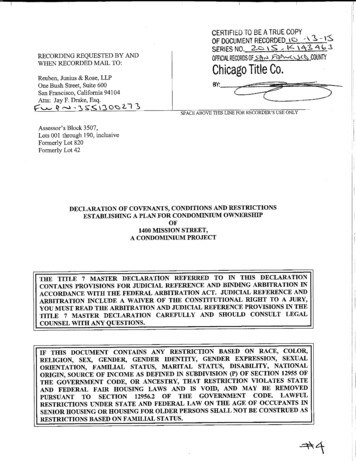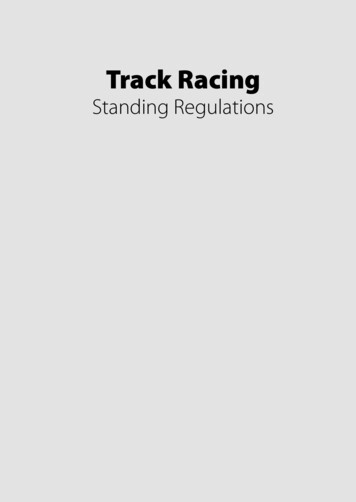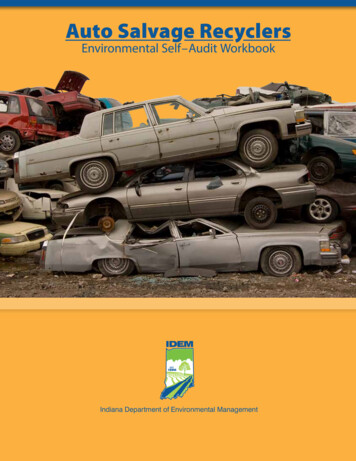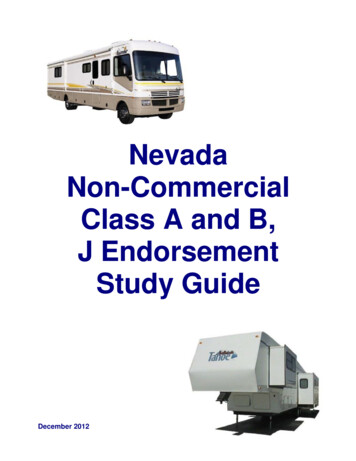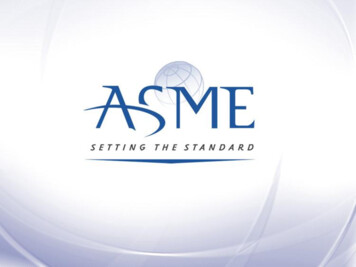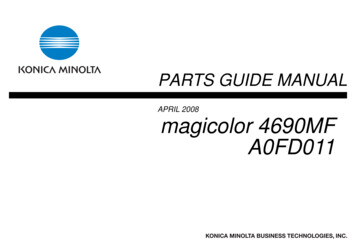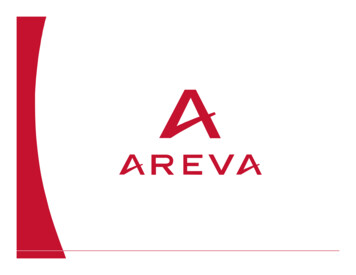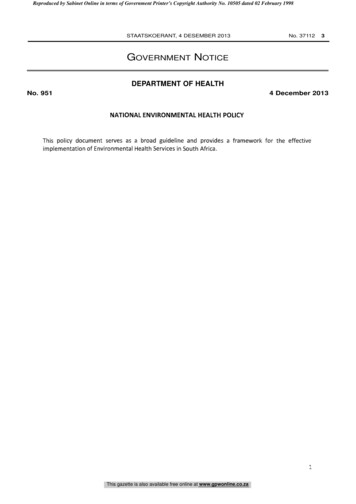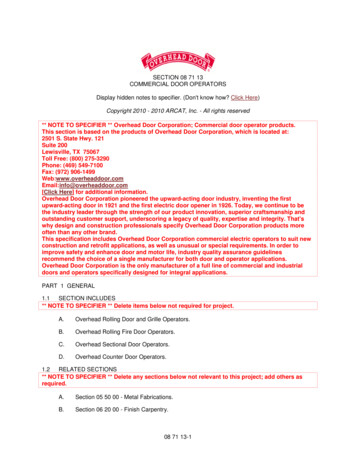
Transcription
SECTION 23 52 16.13 SAMPLE SPECIFICATION FOR STAINLESS-STEEL CONDENSINGBOILERSHARSCO INDUSTRIAL, PATTERSON-KELLEY STORM CONDENSING BOILERSW/ NURO CONTROLPart 1 - GENERAL1.01RELATED DOCUMENTSA. ANSI Z21.13 / CSA 4.9 (Gas Fired Low Pressure Steam and Hot Water Boilers)B. ASME Section IV (“H” Stamp Heating Boilers)C. ASME CSD-1 (Controls and Safety Devices)D. NBIC - Part 1 (Installation)E. NFPA 54/ANSI Z221.3 (National Fuel Gas Code)F. NFPA 70 (National Electric Code)1.02SUMMARYA. This section includes gas-fired, high efficiency condensing hot water boilers withStainless Steel heat exchangers.B. Related Sections include, but are not limited to, the following:1. Section 03 30 00 “Cast-in-Place Concrete”2. Section 23 01 00 “Operation and Maintenance of HVAC Systems”3. Section 23 05 16 “Expansion Fittings and Loops for HVAC Piping”4. Section 23 05 19 “Meters and Gages for HVAC Piping”5. Section 23 05 23 “General-Duty Valves for HVAC Piping”6. Section 23 05 29 “Hangers and Supports for HVAC Piping and Equipment”7. Section 23 05 48 “Vibration and Seismic Controls for HVAC Piping ”8. Section 23 05 53 “Identification for HVAC Piping and Equipment”9. Section 23 07 19 “HVAC Piping Insulation”10. Section 23 09 13 “Instrumentation and Control Devices for HVAC”11. Section 23 11 23 “Facility Natural-Gas Piping”12. Section 23 11 26 “Facility Liquefied-Petroleum Gas Piping”13. Section 23 21 00 “Hydronic Piping and Pumps”14. Section 23 25 13 “Water Treatment for Closed-Loop Hydronic Systems”15. Section 23 37 00 “Air Outlets and Inlets”16. Section 23 51 00 “Breechings, Chimneys, and Stacks”17. Section 23 53 00 “Heating Boiler Feedwater Equipment”STORM BoilersPage 1Section 23 52 16.13
1.03 SUBMITTALSA. The contractor shall submit, in a timely manner, all submittals for approval to the engineer.Under no circumstances shall the contractor install any materials until the engineer hasmade final approval on the submittals.B. Product data and/or drawings shall be submitted to the engineer for approval and shallconsist of:1. General assembly drawing of the boiler including product description, modelnumber, dimensions, clearances, weights, service sizes, etc.2. Schematic flow diagram of the boiler’s gas valve train(s).3. Schematic wiring diagram of the boiler’s control system that shows allcomponents, interlocks, etc. and shall clearly identify factory wiring and fieldwiring.C. Full Function Factory Fire Test must be performed and documented on the boiler’s firetest label. A Factory Authorized Start-up must be completed prior to final acceptance bythe engineer.D. Operation and Maintenance Manuals shall be submitted prior to final acceptance by theengineer and shall contain shop drawings, product data, operating instructions, cleaningprocedures, replacement parts list, maintenance and repair data, etc.1.04 QUALITY ASSURANCEA. The equipment shall, at a minimum, be in strict compliance with the requirements of thisspecification, shall perform as specified and shall be the manufacturer's standardcommercial product unless specified otherwise.B. Electrically operated components specified are to be “Listed” and/or “Labeled” as definedby NFPA 70, Article 100.C. Boiler shall bear an ASME “H” stamp in accordance with ASME Section IV.D. Boiler shall be CSA certified to the ANSI Z21.13 / CSA 4.9 standard for Gas Fired LowPressure Steam and Hot Water Boilers and shall bear an authorized CSA rating label.E. Boiler shall be AHRI listed and certified in accordance with the Commercial Boiler programand the BTS-2000 testing standard.F. Boiler shall undergo a Full Function Factory Fire Test and bear a fire test label.G. Boiler shall be registered through the National Board from the factory.H. The manufacturer shall make available, upon request, all quality assurance documentationand results of Full Function Factory Fire Test based on the boiler’s serial number.STORM BoilersPage 2Section 23 52 16.13
1.05 COORDINATIONA. Equipment shall be handled, stored and installed in accordance with the manufacturer’sinstructions.B. Factory Authorized Start-up must be completed after all appliance connections arecompleted, e.g. gas piping, hydronic piping, exhaust venting & electrical.1.06 WARRANTYA. The boiler manufacturer shall warrant each boiler, including boiler, trim, boiler controlsystem, and all related components, accessories, and appurtenances against defects inworkmanship and material for a period of twelve (12) months from date of startup,provided that startup is completed within six (6) months of shipment and the start-up reportis furnished to the manufacturer within thirty (30) days of startup.B. The boiler manufacturer shall warrant the boiler’s fuel burner for a period of five (5) yearsfrom date of startup, provided that startup is completed within six (6) months of shipmentand the start-up report is furnished to the manufacturer within thirty (30) days of startup.C. The boiler manufacturer shall warrant the boiler’s heat exchanger for a period of ten (10)years from date of startup, provided that startup is completed within six (6) months ofshipment and the start-up report is furnished to the manufacturer within thirty (30) days ofstartup.D. The boiler manufacturer shall also warrant the boiler’s heat exchanger against failure dueto thermal shock for a period of ten (10) years from date of startup, provided that startup iscompleted within six (6) months of shipment and the start-up report is furnished to themanufacturer within thirty (30) days of startup.1.07 CERTIFICATIONA. Manufacturer’s Certification - The boiler manufacturer shall certify the following:1. The products and systems furnished are in strict compliance with thespecifications.2. The boiler, burner and other associated mechanical and electrical equipmenthave all been properly coordinated and integrated to provide a complete andoperable boiler.3. The boiler shall be in compliance with ANSI Z21.13 / CSA 4.9 (latest edition).4. The boiler shall be CSA certified for at least 96% efficiency based on operatingconditions specified for testing under ANSI Z21.13 / CSA 4.9.5. The boiler shall be AHRI certified for at least 96% efficiency based on operatingconditions specified for testing under BTS-2000.6. The boiler shall be in compliance with ASME Section IV (latest edition).7. The boiler shall be in compliance with ASME CSD-1 (latest edition).8. The boiler’s H-3 form shall be registered with the National Board.STORM BoilersPage 3Section 23 52 16.13
B. Contractor’s Certification - The installing contractor shall certify the following:1. The products and systems installed are in strict compliance with thespecifications and all applicable local and/or state codes.2. The specified field tests have been satisfactorily performed by a factoryauthorized startup agent.3. The equipment furnished contains inter-changeable parts with the specifiedequipment so that all major equipment parts can be obtained from the specifiedmanufacturer.Part 2 - Product2.01MANUFACTURERSA. Furnish and install factory “packaged” low pressure hot water boiler(s) as manufactured byHarsco Industrial, Patterson-Kelley or as approved and accepted by the Engineer asdefined in the table below:ModelNumberFuelTypeVentCategoryMax InputHigh Fire(BTU/Hr)Min InputLow Fire(BTU/Hr)TurndownRatioMax Output(BTU/Hr)AHRIEfficiencyST-1250NGII or IV1,250,000125,00010:11,212,50097%ST-1500NGII or IV1,500,000150,00010:11,455,00097%ST-1750NGII or IV1,750,000175,00010:11,697,50097%ST-2000NGII or IV2,000,000200,00010:11,940,00097%B. Each factory “packaged” boiler shall be complete with all components and accessoriesnecessary for a complete and operable boiler as hereinafter specified. Each boiler shallbe furnished factory assembled with the required wiring and piping as a self-containedunit. Each boiler shall be readily transported and ready for installation.C. All “Approved Equal” or “Approved Alternate” boilers must demonstrate compliance withthe requirements of this specification.STORM BoilersPage 4Section 23 52 16.13
2.02COMPONENTSA. CABINET ENCLOSURE1. Each boiler shall feature a fully assembled cabinet enclosure fabricated fromCarbon Steel or Aluminum sheet metal (minimum 16 Gauge) with powdercoat finish.2. The boiler’s cabinet enclosure shall not exceed 34” in width and thecompleted boiler shall fit through a standard 36” wide doorway.3. The boiler’s cabinet enclosure shall feature removable access panels / doorsthat can be easily opened.4. The boiler’s cabinet enclosure shall eliminate the use of refractory or otherinsulating materials by baffling the combustion air around the heat exchangerand the outer surface temperature shall not exceed 20 F above ambienttemperature.5. The boiler’s cabinet enclosure shall prominently display all required safety,instruction, compliance and factory runout labels.B. HEAT EXCHANGER1. Each water-tube boiler shall contain an ASME Section IV heat exchanger withan “H” stamp designed for a maximum allowable working pressure of 160PSIG and a maximum allowable temperature of 210 F.2. The completed heat exchanger shall consist of welded 316L SS helical watertubes and provide no less than the total fireside heating surface area definedin the table below:Heating Surface AreaST1250ST1500ST1750ST2000100.17 ft2119.8 ft2153.19 ft2153.19 ft23. Each completed heat exchanger shall include an integral stainless steelcondensate pan/collector, condensate drain, removable burner assembly,inlet temperature sensor, outlet temperature sensor, flue gas temperaturesensor, heat exchanger temperature sensor, automatic air vent, thermowellfor high temperature limit capillary, low water cutoff probe or flow switch, andall necessary assembly hardware.4. Each stainless steel heat exchanger shall be designed to maintain waterturbulence at the full published range of acceptable flow rates at variousboiler conditions as described below:a. The maximum allowable flow rate will generate a 20 F ΔT when theboiler is operating at full capacity.b. The minimum allowable flow rate will generate a 63 F ΔT when the boileris operating at full capacity.STORM BoilersPage 5Section 23 52 16.13
5. The boiler’s completed heat exchanger shall be capable of operating with aminimum outlet water temperature of 42 F.6. Each heat exchanger must be hydrostatically tested by the manufacturer to aminimum of 1-1/2 times the maximum allowable working pressure for aminimum of 5 minutes. During this hydrostatic pressure test, the operator willinspect the pressure gauge and visually verify there are no water leaks.C. MAIN GAS TRAIN1. Boilers configured for single fuel operation shall be equipped with an integralmain gas valve train capable of burning Natural Gas.2. Each gas valve train shall include at least the following:a. One (1) upstream manual shutoff valve for field-connection.b. One (1) combination Air-Gas ratio control and safety shutoff valve withdual solenoids (in-series) that can be independently energized for leaktesting and integrated into a single body design. The combination gasvalve shall operate as a “Zero Governor” and control to a neutral gaspressure inside the gas valve.c. One (1) low gas pressure switch (manual reset).d. One (1) high gas pressure switch (manual reset).e. Two (2) gas pressure test ports.f. One (1) downstream manual shutoff valve.3. Each gas train shall be completely independent and include dedicated safetydevices, shutoff valves, etc. Each gas train shall be individually identified by themanufacturer with labels and dedicated paint colors (Yellow Natural Gas).4. The main gas valve train(s) shall be factory assembled, piped, and wired andallow for operation at full rated boiler capacity from 3.5 - 4.0” W.C. up to themaximum inlet gas pressure of 14.0” W.C.5. If the supplied gas pressure exceeds 14” W.C., the contractor shall supply asuitable intermediate gas pressure regulator of the lock-up type to reduce thegas pressure to acceptable levels.STORM BoilersPage 6Section 23 52 16.13
D. POWER BURNER1. The boiler manufacturer shall furnish an integral power type fuel burner witheach boiler. The complete power fuel burner assembly shall consist of a gasburner, combustion air blower, main gas valve train, and ignition system. Theburner manufacturer shall fully coordinate the burner design with the boiler’sheat exchanger and the boiler control system in order to provide the requiredcapacities, efficiencies, and performance specified. Boilers shipped without apower burner and field-equipped with a 3rd party power burner are notacceptable.2. Each burner shall be installed horizontally inside the combustion chamber withcombustion gases flowing downward through the heat exchanger. The burnershall consist of a stainless steel flange and perforated stainless steel cylinder.3. Each boiler shall be equipped with direct spark ignition. Main flame shall bemonitored and controlled by a flame rod / ionization probe (rectification) system.E. BOILER SAFETY and TRIM DEVICES1. The boiler manufacturer shall furnish and test the following safety and trimdevices with each boiler:a. Safety relief valve shall be provided in compliance with the ASME code.Contractor is required to pipe the relief valve discharge piping to anacceptable drain.b. Water pressure/temperature gauge.c. Low Water / Flow cutoff.d. Manual reset high limit water temperature controller.e. Operating temperature control to control the sequential operation of theburner.f. High and Low Gas Pressure switches.g. Flame rod / ionization probe flame detection.2. The boiler manufacturer shall provide a CSD-1 form identifying each safety andtrim device.3. The boiler shall be capable of interfacing with the following external safetydevices:a. Auxiliary Low Water Cutoff device.b. Combustion Air Damper End Limit Switch.c. Emergency Stop (E-Stop) switch.d. External Safety Device w/ contact closure.STORM BoilersPage 7Section 23 52 16.13
F. BOILER CONTROL SYSTEM1. Each boiler shall be provided with all necessary controls, all necessaryprogramming sequences, and all safety interlocks. Each boiler control systemshall be properly interlocked with all safeties.2. Each boiler shall be provided with a “Full Modulating” firing control systemwhereby the firing rate is infinitely proportional at any firing rate between low fireand high fire as determined by the pulse width modulation input control signal.Both fuel input and air input must be sequenced in unison to the appropriatefiring rate without the use of mechanical linkage.3. The boiler’s control system shall provide the minimum capabilities:a. 7” color touchscreen display with one or more USB ports.b. Standard on-board Ethernet port for wired internet connectivity andembedded wireless driver for optional wireless internet connectivity toremote monitoring and software update services.c. Parameter uploads and downloads via external USB flash drive.d. Software updates via external USB flash drive.e. Capture screen shots from the control’s display by saving digital imagefiles to external USB flash drive.f. Local Representative Screen can be programmed to provide contactinformation for the local boiler manufacturer’s representative.g. Programmable Relay Outputs for direct control of pumps, control valves,dampers and other auxiliary devices.h. Multiple boiler “cascade” network up to 24 boilers without any externalcontrol panel. The installation of external sequencing control panels isnot acceptable.i.Automatic hybrid system control for multiple boiler “cascade” systemswith both condensing and non-condensing boilers. This control logicprioritizes condensing boilers at low water temperatures and prioritizesnon-condensing boilers at high water temperatures.j.Auxiliary Boiler Relay for multiple boiler “cascade” systems which can beused to enable a 3rd party boiler platform in the event the “cascade”system is unable to satisfy the heating load.k. Programmable Boiler and System pump control for multiple boiler“cascade” systems installed in a Primary-Secondary piping arrangement.l.Programmable Control Valve logic for multiple boiler “cascade” systemsinstalled in a Primary-Only piping arrangement.m. Integration with external Building Management Systems (BMS) viaMODBUS RTU protocol. NOTE: Optional Protocol Converter forcommunication via LONWORKS and BACnet must be available forpurchase from the boiler manufacturer.n. Hardwire integration with Building Management Systems (BMS) via 4STORM BoilersPage 8Section 23 52 16.13
20mA analog control signal for temperature or firing rate control.o. Intuitive “Setup Wizards” ask the user a series of questions and allow forstep-by-step configuration of the boiler control.p. On-Screen error notifications with a comprehensive description of allalarm conditions and several troubleshooting steps.q. Automatic flue gas temperature and outlet (supply) temperaturecompensation to prevent over-firing of the boiler equipment.r. Automatic differential temperature compensation to prevent over-firing ofthe boiler equipment in a low flow condition.s. Automatically adjust the temperature set point and shutdown the boilerbased on the outdoor air temperature conditions.t. Night Setback functionality via external point of closure (or BMSintegration) for unique “Occupied” and “Unoccupied” temperaturesetpoint values.u. Maintain single temperature set point with a minimum outlet (supply)water temperature of 42 F up to a maximum outlet (supply) watertemperature of 194 F.v. On-Board DHW Priority capable of seamless transition between ComfortHeat (CH) and Domestic Hot Water (DHW) operation.w. On-Board CH&DHW operation for simultaneous Comfort Heat (CH) andDomestic Hot Water (DHW) operation.x. Alarm Relay Output to announce alarm conditions which require manualreset.y. Programmable Low Fire Delay to prevent excessive short-cycling of theboiler equipment.z. Local Manual Operation.2. The boiler control system shall be capable of interfacing with the followingexternal control devices:a. Building Management System (MODBUS ). NOTE: Optional ProtocolConverter for communication via LONWORKS and BACnet must beavailable for purchase from the boiler manufacturer.b. Domestic Hot Water Break-on-Rise Aquastat (Normally Closed).c. Domestic Hot Water Tank Temperature Sensor (12kΩ).d. External Header Temperature Sensor (12kΩ).e. Outdoor Air Temperature Sensor (12kΩ).STORM BoilersPage 9Section 23 52 16.13
Part 3 - Execution3.01INSTALLATIONA. Installation shall be performed by the contractor in accordance with the requirements ofthe applicable codes. Contractor shall review the boiler and installation for compliancewith requirements and/or issues that may affect boiler performance. Installation shouldnot proceed until unsatisfactory conditions have been corrected.B. The contractor shall mount the equipment as described below:1. Install boilers on cast-in-place concrete equipment base in compliance withthe requirements for equipment bases and foundation specified in Section 0330 00 “Cast-in-Place Concrete.”2. If required by the local code, install vibration isolation devices in compliancewith Section 23 05 48 “Vibration and Seismic Controls for HVAC Piping andEquipment.”C. The contractor shall install gas-fired boilers in accordance with NFPA 54/ANSI Z223.1(United States), or CAN/CSA B/149.1 (Canada).D. The contractor shall install gas-fired boilers in accordance with NBIC – Part 1(Installation), or another installation code having local jurisdiction.E. The contractor shall assemble and install any external boiler safety/trim devices.F. The contractor shall install any electrical devices furnished with the boiler, but notspecified to be factory-mounted.G. The contractor shall install control wiring to field mounted electrical devices inaccordance with the requirements of NFPA 70.H. The contractor shall install electrical (power) wiring to the boiler in accordance with therequirements of NFPA 70.3.02CONNECTIONSA. GAS PIPING1. Each boiler shall be provided with all necessary gas connections. Refer tothe boiler’s specification sheet or manual for connection sizes.2. Install gas piping in accordance with NFPA 54/ANSI Z223.1 (United States),or CAN/CSA B/149.1 (Canada).3. For boilers configured for Natural Gas, refer to the requirements of Section 2311 23 “Facility Natural-Gas Piping”.STORM BoilersPage 10Section 23 52 16.13
B. HYDRONIC PIPING1. Each boiler shall be provided with all necessary inlet (supply) and outlet (return)connections. Refer to the boiler’s specification sheet or manual for connectionsizes.2. Check manufacturer’s installation manual for clearance dimensions and installpiping that will allow for service and ease of maintenance.3. Install piping from equipment drain connection to nearest floor drain. Pipingshall be at least full size of connection and adhere to proper codes forneutralization.4. The hydronic piping and related components shall comply with therequirements of 23 21 00 “Hydronic Piping and Pumps”.5. All meters and gages in the hydronic piping shall comply with therequirements of Section 23 05 19 “Meters and Gages for HVAC Piping”.6. All instrumentation and controls in the hydronic piping shall comply with therequirements of Section 23 09 13 “Instrumentation and Control Devices forHVAC”.7. All valves in the hydronic piping shall comply with the requirements of Section23 05 23 “General-Duty Valves for HVAC Piping”.8. All expansion fittings shall comply with the requirements of Section 23 05 16“Expansion Fittings and Loops for HVAC Piping”.9. Any pipe hangers or supports shall comply with the requirements of Section23 05 29 “Hangers and Supports for HVAC Piping and Equipment”.10. Any vibration isolation devices on the hydronic piping shall comply with therequirements of Section 23 05 48 “Vibration and Seismic Controls for HVACPiping and Equipment.”11. The feedwater piping shall comply with the requirements of Section 23 53 00“Heating Boiler Feedwater Equipment”.12. The hydronic piping shall be insulated in accordance with the requirements ofSection 23 07 19 “HVAC Piping Insulation”.13. After insulation, all hydronic piping shall be identified in accordance with therequirements of Section 23 05 53 “Identification for HVAC Piping andEquipment”.14. Any water treatment of the hydronic system shall be in accordance with theboiler manufacturer’s requirements and/or Section 23 25 13 “Water Treatmentfor Closed-Loop Hydronic Systems”.STORM BoilersPage 11Section 23 52 16.13
C. EXHAUST VENTING1. The boilers shall be dual certified as Category II or IV appliances and arecapable of operating with slightly negative to slightly positive exhaust ventpressure, and the vent gas temperature is likely to cause condensateproduction in the vent.2. Install the exhaust/flue venting system in accordance with NFPA 54/ANSIZ223.1 (United States), or CAN/CSA B/149.1 (Canada) and per themanufacturer’s recommendations in the installation manual.3. All exhaust venting components shall comply with the requirements of Section23 51 00 “Breechings, Chimneys and Stacks.”D. AIR INLET1. The boilers shall be certified for Direct Vent / Sealed Combustion installationswhere the combustion air is supplied directly to the boiler through ductwork.2. Install the air inlet system in accordance with NFPA 54/ANSI Z223.1 (UnitedStates), or CAN/CSA B/149.1 (Canada) and per the manufacturer’srecommendations in the installation manual.3. All air inlet components shall comply with the requirements of Section 23 37 00“Air Outlets and Inlets”.E. ELECTRICAL1. Install an external disconnect and overload protection for each boiler inaccordance with the requirements of NFPA 70.2. The voltage requirements for each boiler shall be configured for 208-240VAC,Single Phase (w/ Neutral), 60Hz.3. The amperage requirements for each boiler is described in the table below:STORM dProtection20 Amps20 Amps20 Amps20 AmpsRecommendedCircuitCapacity20 Amps20 Amps20 Amps20 AmpsPage 12Section 23 52 16.13
BOILERS HARSCO INDUSTRIAL, PATTERSON-KELLEY STORM CONDENSING BOILERS W/ NURO CONTROL Part 1 - GENERAL 1.01 RELATED DOCUMENTS A. ANSI Z21.13 / CSA 4.9 (Gas Fired Low Pressure Steam and Hot Water Boilers) B. ASME Section IV ("H" Stamp Heating Boilers) C. ASME CSD-1 (Controls and Safety Devices) D. NBIC - Part 1 (Installation)

